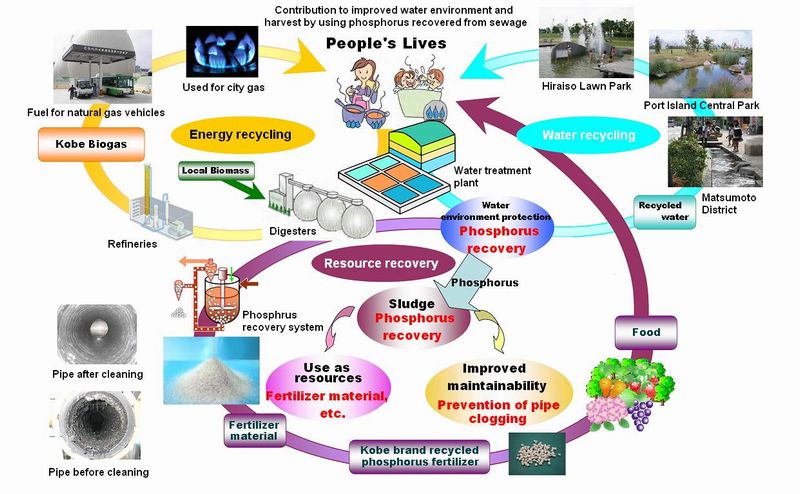- HOME>
- NEWS>
- INFORMATION>
- Adopted as a B-Dash Project
May.11.2012
Adopted as a B-Dash Project
“Kobe Harvest Project”:phosphorus recovery demonstration project for innovative technologies for nutrient removal and resource (phosphorus) recovery at the Higashinada Sewage Treatment Plant in Kobe
The “Kobe Harvest Project”, proposed by the research consortium consisting of Swing Corporation, Kobe City, and Mitsubishi Shoji Agri-Service Corporation, was adopted as a Breakthrough by Dynamic Approach in Sewage High Technology Project(B-Dash project) by the Ministry of Land, Infrastructure, Transport and Tourism on March 30, 2012.
The proposal, which is the combination of Swing Corporation's phosphorus removal and recovery technologies, the forward thinking approach of Kobe City, and the fertilizer company’s strategy of seeking a practical use for recovered phosphorus, has been highly appreciated.
In order to protect the water quality of closed waters, such as Osaka Bay, it is vital to remove nutrients (phosphorus and nitrogen) that can cause red tides. Meanwhile, phosphorus, one of the three major nutrients along with nitrogen and potassium, has been extensively used as fertilizer. However, the limited reserves of phosphorus as an exhaustible resource are of international concern, and Japan entirely depends on imports to satisfy its entire demand for phosphorus. The project aims to efficiently recover phosphorus, one of the valuable resources, from sewage, which might be called “an urban phosphate mine”, and to reuse it as high quality fertilizer.
Members of the research consortium and their roles
・Swing Corporation (President: Masayoshi Hirose): Construction and operation of a demonstration unit, data analysis, etc.
・Kobe City (Mayor: Tatsuro Yada): Facility operation and coordination, etc.
・Mitsubishi Shoji Agri-Service Corporation (President: Seiji Miyake): Feasibility study of fertilizer production, etc.
Proposal by the research consortium
・Water environment protection and resource recovery:
Using innovative technologies, phosphorus will be efficiently removed and recovered from digested sludge with a high phosphorus concentration. The project aims to recover phosphorus in a form suitable for producing fertilizer.
・Confirmation of dewaterability and improvement of maintainability:
The maintainability of water and sludge treatment processes will be improved by removing phosphorus, a cause of pipe clogging.
・Contribution to “harvest”:
Through the feasibility study of fertilizer production using recovered phosphorus and supplying it as “Kobe brand recycled phosphorus fertilizer material”, the project to utilize sewage as a rich resource will contribute to “harvest”.
Scheduled demonstration
・Construction of a demonstration unit (digested sludge treatment capacity: 239 ㎥/d, MAP recovery: 150 t/y), collection and analysis of operation data
・Demonstration of an inexpensive system with excellent operability and maintainability to enable the widespread use of the system
・Verification of reduction in the operating cost of the whole sewage treatment plant
・Verification of the usability of recovered phosphorus as fertilizer material
Innovative phosphorus removal and recovery technologies
・Thanks to its high reaction efficiency, the system considerably reduces construction and maintenance costs.
・The project aims for Japan's first practical application of phosphorus removed and recovered from digested sludge to fertilizer material.
・The award-winning and technologies patent protected.

■About the 2012 B-DASH Project
The purpose of the project is to achieve considerable cost reduction in sewage works and generation of renewable energy and to embrace the support of Japanese companies’ water business overseas by accelerating research and development as well as practical application of new technologies. This project is a growth strategy of the Ministry of Land, Infrastructure, Transport and Tourism, which invites research organizations to apply for new technology projects and implement demonstration by establishing real-scale demostration plants.

